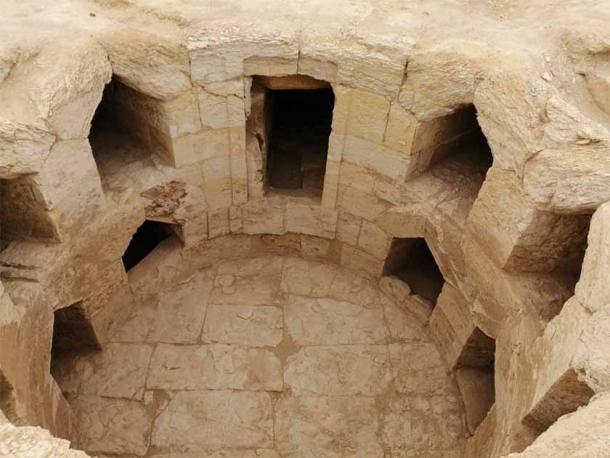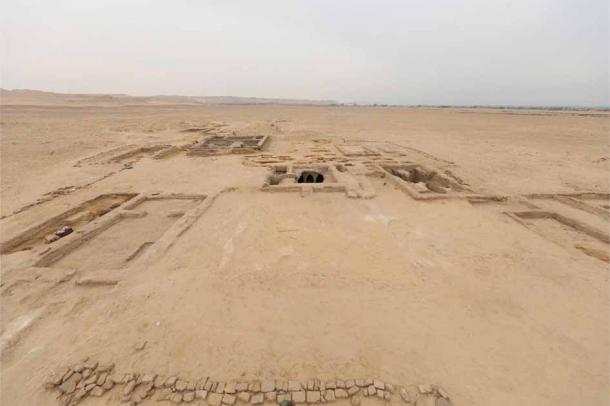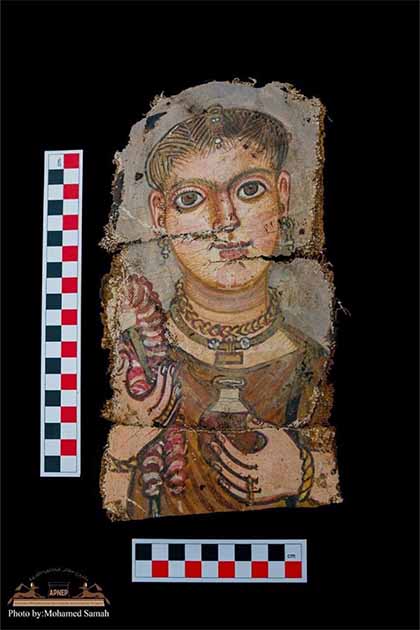A huge funerary building has been excavated by researchers at the Gerza archaeological site in Fayum, Egypt. Rare artifacts were discovered, but a collection of mummy portraits represent the first such discovery for over 100 years.
Established in the 3rd century BC about 80 kilometers (50 miles) south of Cairo, Gerza was a central village in Fayum within the agricultural reclamation project implemented by King Ptolemy II (309 to 246 BC). Inhabited by both Egyptians and Greeks, Gerza was known to the latter as Philadelphia and its primary function was producing and exporting food supplies to the Egyptian kingdom.
Elite Gersha residents were buried in a huge tomb deep beneath the sandy streets of this agricultural outpost, and within it, archaeologists recovered the dusty faces of deceased ancient Egyptians in a collection of rare ancient mummy portraits.

One of the burial chambers at the newly uncovered site at Gerza. ( Ministry of Tourism & Antiquities )
Coming Eye-to-Eye with Ancient Egyptian Mummy Portraits
Dr. Mostafa Waziri, Secretary General of the Supreme Council of Antiquities, said In a press release that the “huge” funerary structure was first identified in 2016. He said both the architecture and artifacts recovered within date back to the ancient Egyptian and Greek civilizations. To the south of the tomb’s colored lime mortar floor, which was finished with interchangeable tiles, a column shed was found containing four broken columns.
Heritage Daily reported that the funerary building was constructed of stone blocks and descended several floors into the ground. Towering arched stone doorways lead to six huge mud-brick tombs representing what the discoverers described as “mass graves in the Catacomb style.” Within the burial chambers archaeologists discovered “intricately decorated wooden coffins” carved in both ancient Egyptian and Greek letters.
However, the find that’s making the headlines was a group of well-preserved mummy portraits offering insights into the lives of the long-deceased ancient Egyptians.

The archaeological site in the Gerza cemetery where the rare mummy portraits were discovered. ( Ministry of Tourism & Antiquities )
Mummy Portraits Guarded by the Goddess Isis-Aphrodite
Dr. Adel Okasha, head of the Central Department of Egyptian Antiquities in Central Egypt, said the mummy portraits were unearthed on the tenth excavation season of the archaeological mission. He explained that the new discoveries show the “diversity and difference in the accuracy and quality of the embalming process during the Ptolemaic and Roman eras.” What this means is that the corpses of deceased elites were given “high-quality embalming,” while lower-upper classes were left to rot.
Basem Gehad, the head of the mission, said the excavators recovered several different styled coffins, including some in human form and others in the Greek form with a gabled cover. Inside one of the wooden coffins the researchers found “a rare terracotta statue of the goddess Isis- Aphrodite,” the great fertility goddess associated with marriage, childbirth and rebirth. Furthermore, papyrus records written in Demotic and Greek script revealed the social, economic and religious conditions of the regional inhabitants, added Okasha.
Waiting 115 Years for Comparative Mummy Portraits
Okasha said the primary reason the mummy portraits are being heralded as “the most important discovery,” is because the last discovery of portraits in Fayum was made over 115 years ago by the English Egyptologist Sir William Matthew Flinders Petrie.
In the 1990s the British Museum hosted an exhibition titled Ancient faces: mummy portraits from Roman Egypt . This exhibit shared their understanding of mummy portrait painting technologies and materials. Now, these new portraits will allow for comparative analysis, revealing even more about how these arts were created.

One of the rare mummy portraits discovered in Egypt. ( Ministry of Tourism & Antiquities )
Unearthing an Ancient Settlement Lost in the Sands of Time
According to a 2019 research paper published at Brigham Young University by Professor Kerry Muhlestein, the multinational settlement of Gerza (Philadelphia) is located where local hills provide access from the Nile Valley . It was ideally positioned for settling mercenaries, trade, distributing goods, to protect the Fayum and to collect taxes.
A military fortress was built to defend the site at the beginning of the 4th century, which indicates it was still flourishing at the time. Nevertheless, the settlement population declined rapidly soon after indicating the collapse of Gerza in the mid-4th century.
Gerza, Tanis, and all the other surrounding trading centers declined in the 4th and 5th centuries AD after the silting up and other damage to the Bahr Seila, which was “the agricultural lifeblood” for the communities of the northeast Fayum, according to Muhlestein. As the villages were abandoned the stories of the people were windswept and covered beneath the sand of time and lost for the last 2,300 years. This is why the mummy portraits are so important to archaeology: because they let us come face to face with ancient agriculturalists and traders living outside the mega-cities.
Top image: Composite image of the rare mummy portraits unearthed in Egypt. Source: Ministry of Tourism & Antiquities
By Ashley Cowie
 RSS Feed
RSS Feed















 December 6th, 2022
December 6th, 2022  Awake Goy
Awake Goy  Posted in
Posted in  Tags:
Tags: 













